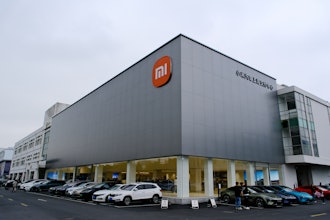
Zebra Technologies
FUTURE PROOFING YOUR OPERATION:
4 Technology Trends Every Manufacturer
Needs to Remain Competitive
2Future Proofing Your Operation: 4 Technology Trends Every Manufacturer Needs to Remain Competitive
FUTURE PROOFING YOUR OPERATION:
4 Technology Trends Every Manufacturer Needs to Remain Competitive
The manufacturing industry is changing rapidly with the evolution of technology happening at
light speed. In order to keep your manufacturing operations and supply chain up-to-date and
competitive, there are a handful of technologies and processes you should implement to
future-proof your operations.
While it’s impossible to predict the future, you can make sure your company is prepared for new
innovations by investing in flexible platforms that are designed to adapt to evolving business
needs. Below, we’ve listed four of these critical technology areas where big changes are underway.
2D Scanning
Manufacturers across vertical industries have been migrating from linear (or 1D) barcodes
to two-dimension (2D) codes for several years, but that shift has reached a tipping point as
companies look for ways to increase the amount of data available at the point of use.
1D/linear codes, like the common UPC code found on consumer goods, use variable-width lines
and space to encode data. They can hold just a few dozen characters, and the codes have to
3Future Proofing Your Operation: 4 Technology Trends Every Manufacturer Needs to Remain Competitive
increase in physical length as more data is added. To be useful, the characters in the barcodes
must be linked to an item in a central database.
2D codes, on the other hand, use patterns of shapes to encode data. They can be much
smaller, while simultaneously encoding much more data (up to 7,000 digits or 4,000 characters
of information). Data is encoded both horizontally and vertically (thus the 2D designation). In
addition, 2D barcodes can encode images, website addresses, voice, and other data. So unlike
1D codes, you can extract meaningful data from the barcode without database connectivity.
While 1D codes were traditionally read with laser scanners, imager scanners which read both
2D and 1D barcodes are common on most industrial barcode scanners, mobile computers, and
consumer devices and phones equipped with basic cameras.
This makes 2D codes much more versatile. The barcodes are inexpensive to create and you can
even make personalized QR codes for free online, and items can be more easily scanned as
they move through assembly lines because the scanners and codes don’t have to be perfectly
aligned. Imagers can also scan multiple codes at the same time.
Because 2D codes can be produced in very small sizes and even physically etched onto items,
they are perfect for marketing electronics (including tiny components), pharmaceuticals, and
medical equipment as they can encode the large amounts of product information necessary for
tracking and compliance.
With the price of 2D barcode scanners dropping, now is the time to invest in this flexible and
adaptable automatic identification technology.
4Future Proofing Your Operation: 4 Technology Trends Every Manufacturer Needs to Remain Competitive
There has been a significant shift in the mobile computing market when it comes to operating
systems. While Windows was once the de facto standard for most mobile devices, there has
been a migration toward the Android OS. With 80% of worldwide smartphone shipments based
on the Android platform, the OS benefits from extensive development and diagnostic tool
support, a familiar UI/UX for end users, a large community of accessible programmers, a large
number of off-the-shelf applications, and a high degree of continuous innovation.
Rugged device manufacturers now offer Android-based tablets, phones, and handheld
computers, and large end users have begun deploying these devices. The fact that there
are now more enterprise-friendly security and containerization features has helped increase
acceptance in these applications.
Because the UI is so familiar through its use in consumer devices, employees will have an easier
time interacting with Android-based devices — which can reduce training costs and effort when
upgrading devices or rolling out new solutions.
Windows CE, meanwhile, has reached the end of its lifecycle. Although it was the most common
industrial mobile OS, Microsoft ended support for the latest version in 2016. Support for legacy
applications is diminishing, and most developers are not targeting the platform for new or
upgraded application software products. The platform also lacks new security protocols or
updates, which will increasingly be a problem as mobile devices are the target of an increasing
number of breaches and attacks. Microsoft also plans to end mainstream support of Windows
8.1 in 2018, and of Windows 10 in 2020.
Mobile OS Migration — From Windows to Android
5Future Proofing Your Operation: 4 Technology Trends Every Manufacturer Needs to Remain Competitive
Microsoft has shifted its focus to Windows 10 Mobile. However, this platform may be too
complex for traditional CE applications and is more locked-down and averse to third-party
extensions than its predecessors. Because it has a relatively low market share, there are also
fewer applications and experienced developers available.
For companies that have invested in extensive legacy applications, the migration to Android
can be challenging, but there are ways to make that transition smoother. Developers can adapt
programs to Android through extensive APIs, for example.
In addition, there are also terminal emulation options. All Touch Terminal Emulation (TE)
for Android devices from Zebra Technologies, for example, updates legacy TE green and
monochromatic screens into graphics-based screens without requiring modification of back-end
systems. The all-touch TE client, powered by Wavelink, allows users to access, manage, and
maintain connections to applications resident on host systems.
Device Management
Enterprise device management (EDM) systems are an evolution of mobile device management
(MDM) solutions, and allow companies to manage all of their devices from a single, centralized
point. With device management solutions, you can improve security and productivity, while also
reducing the burden on your own IT staff.
A robust device management platform provides a number of important benefits:
Security
Business mobility solutions need to be safe, secure, and scalable. EDM can help ensure that
you protect devices from unauthorized access by locking screen passcodes, enabling
device-level encryption, and utilizing mobile malware detection features. These solutions also
provide built-in messaging capabilities so your end users can send secure messages without
risking over-the-air interception.
Remote Device Management
IT staff can take a centralized approach to enrolling, configuring, provisioning, and tracking
mobile devices. If a device is lost or stolen, putting personal or enterprise data at risk, a
manager can remotely lock down the device or even wipe the data from the unit. Managers can
even opt to only delete business data from a device, leaving personal files intact.
6Future Proofing Your Operation: 4 Technology Trends Every Manufacturer Needs to Remain Competitive
Application Control
IT staff can manage the applications on the mobile devices without any time-consuming
employee interactions. Staff can keep their devices and applications up to date without costly
interruptions to their work flow. This capability is also important for security reasons. If employees
download unauthorized apps that are infected by malware, the malicious code could siphon
data from other apps on the device. Application control allows IT to blacklist or disable these
malicious apps.
Content Control
EDM allows companies to control who has permission to view or edit certain documents using
the mobile devices based on their roles or permissions. For devices that employees may use
for both personal and corporate functions, EDM platforms can help partition each device for
dedicated work-use. Untrusted third-party apps can be kept separate from sensitive data.
Real-Time Visibility
EDM enables real-time visibility of every mobile asset across the company. For reporting
purposes, this gives companies real-time insight into device status, log-in attempts, and
compliance with password policies. Managers and IT staff can also easily check each user’s
device warrant, history, software version, device assignment, repair records, and other data to
help monitor and improve device utilization and compliance with corporate use policies.
Central management also helps maximize productivity and device performance. In addition to
having real-time asset tracking data for each device, IT can monitor how well the devices are
performing in the field and if they are being fully utilized. This way, you can ensure that each
device is properly configured and charged, and you can easily identify any problems with
out-of-date software, damaged devices, or those that need repair or maintenance. If there is a
problem with a device in the field, IT can remotely trouble shoot the issue and, in many cases,
issue a patch or fix without having to physically handle the computer. This saves valuable time
for both support staff and field technicians or other employees.
Secure End-of-Life Devices
EDM makes it easier to secure end-of-life mobile devices by ensuring that they are properly
dispensed of, tracked, and have had all data and relevant applications removed prior to disposal.
7Future Proofing Your Operation: 4 Technology Trends Every Manufacturer Needs to Remain Competitive
Barcode printing operations are so ubiquitous in manufacturing that they are almost invisible,
but purchasing the right equipment to streamline the use of printers and consumables can allow
companies to run more efficiently and save costs over time.
Label Printing and Supplies
Printers
Investing in industrial printers that are built to last in tough manufacturing environments is
critical. Rugged printers for high-volume labeling operations and warehouse/factory applications
will last years — in some cases, more than a decade — if they are properly maintained.
Look for printers that can provide fast print speeds and provide USB, Ethernet, and wireless
connectivity. This will allow you to efficiently print the types of labels you need from any device.
Distributed printing functionality is also important in an enterprise setting. This will enable you to
have more printers on the shop floor closer to the point of activity. Desktop units like the Zebra Xi
can be utilized in central label printing areas, while smaller printers can be utilized on each line.
Mobile printers (teamed with rugged mobile computers) are another important option.
Employees can print labels on demand wherever they are working — in a warehouse aisle, on a
forklift, or on the receiving dock.
8Future Proofing Your Operation: 4 Technology Trends Every Manufacturer Needs to Remain Competitive
Labels and Tags
The printer is only part of the equation. Selecting labels, tags, ribbons, and other consumables
that provide the quality and durability you need is another critical element of an effective
printing solution.
Labeling supplies are no longer a commodity. If the label or tag doesn’t perform, the entire
system will fail. Look for labels and tags that have been designed to work with your printers
(which can help extend the life of the equipment), as well as adhesives that will ensure the
label stays in place. The labels should be able to withstand your operational environment
particularly if they will be exposed to weather, chemicals, moisture, and other contaminants.
If the label falls off or the barcode or human-readable information is smeared because of poor
quality consumables, it can create delays or mistakes in manufacturing or shipping/receiving.
If the labels don’t meet the regulatory requirements necessary in your industry, or if they fail
to meet customer specifications, you could face fines, penalties, or even product recalls that
negatively affect your reputation.
And if you haven’t updated your supplies in several years, talk to your printer supplier or value-
added reseller. There may be new consumables available that provide better performance or
lower costs.
When evaluating new technology to help improve
manufacturing operations, be sure to investigate
the type of service and support available for the
equipment and software. The right technology is
critical, but without excellent customer support it can
be a drain on productivity.
Responsive support can help relieve the strain on
your IT department and improve uptime for the
solution. Look for a partner that can provide remote
support via a computer interface, or that will offer
the option of shipping damaged technology to their
service hub for repair.
Don’t Forget: Support and
Professional Services
9Future Proofing Your Operation: 4 Technology Trends Every Manufacturer Needs to Remain Competitive
Reliable support can help safeguard your technology investment, reduce your total cost of
ownership, increase the life of the hardware, and minimize downtime. Unless your IT department
is well versed in every aspect of these technologies (an unrealistic expectation), vendor support
will be a mission-critical component of the deployment.
Choose a partner who can ensure your software links all of your devices and solutions — from
scanners to printers and ERP systems — seamlessly. These services will help you deploy,
integrate and implement your printing and data collection infrastructure.
Services to look for include:
• Onsite and depot support agreements
• Preventative maintenance programs
• Time and materials repair options
• Online and telephone support
• Spares pool management
• Configuration, staging and deployment
• Customer software application development and data integration
Conclusion
Manufacturers can’t rest on yesterday’s technology investments. The rapid evolution of
manufacturing and supply chain technology is forcing the entire manufacturing sector to adapt
quickly, streamline and automate processes, and empower their employees with the latest
mobile computing and data collection solutions.
Employees are at the heart of all of these technology initiatives. Mobility and data collection
technology can help your workers do their jobs faster, better, and more accurately. That makes
for a happier and more productive workforce that can deliver quality and efficiency on the shop
floor — a critical element for future success and competitiveness in manufacturing.
About Coridian Technologies
Coridian is a labeling and barcode solutions provider headquartered in Chanhassen, MN with
an additional sales office in Florida. Coridian specializes in product identification and data
collection solutions (AIDC) for the healthcare, manufacturing, and warehouse/distribution
industries — partnering with leading manufacturers such as Zebra Technologies. Coridian has
been in business for over 20 years, with more than 250 combined years’ experience in the
industry. For more information on Coridian please visit our website at www.coridian.com or call
us at 952-361-9980.
About Zebra Technologies
Zebra makes businesses as smart and connected as the world we live in. Zebra tracking and
visibility solutions transform the physical to digital, creating the data streams enterprises need to
simplify operations, know more about their businesses, and empower their mobile workforces.






















